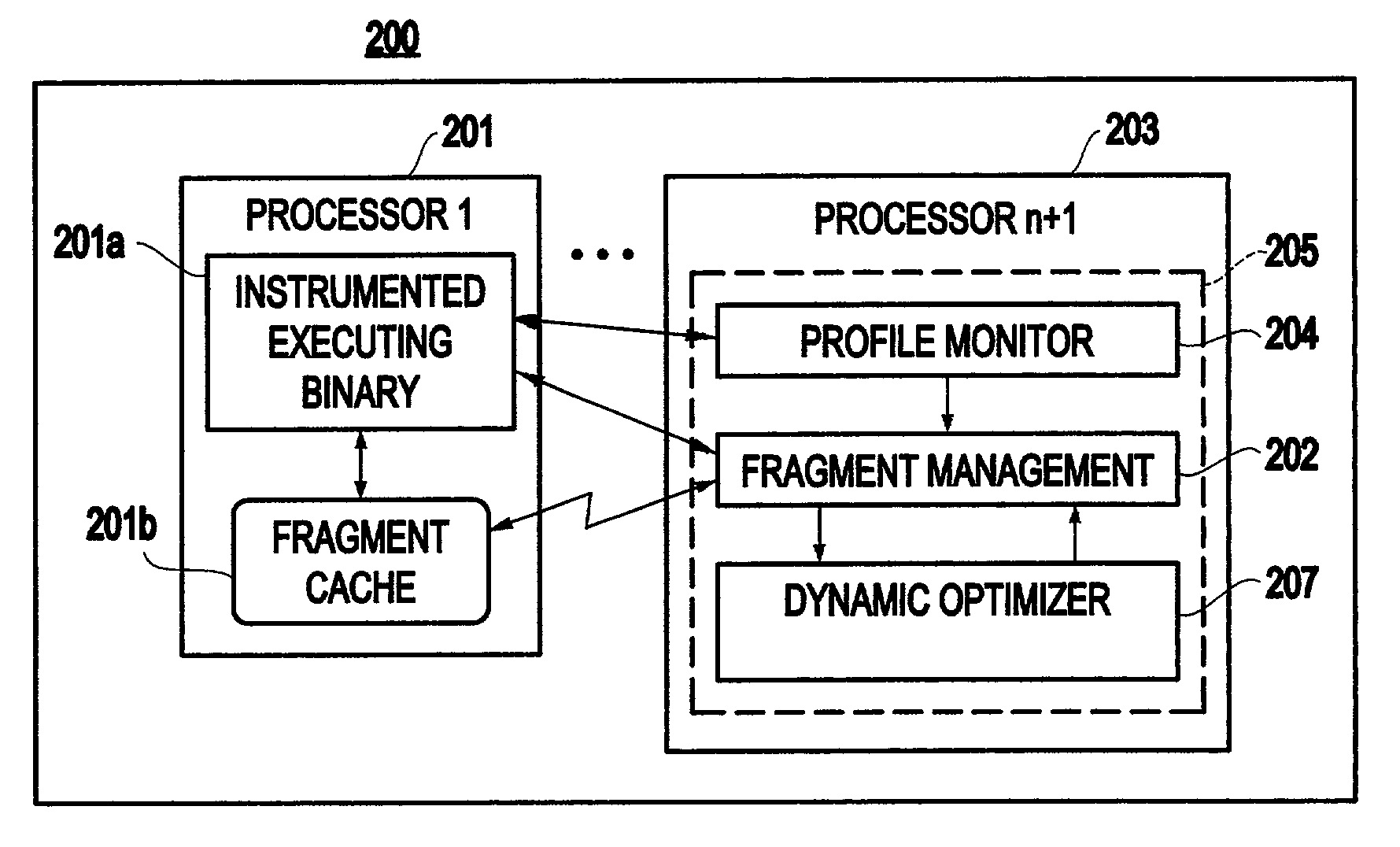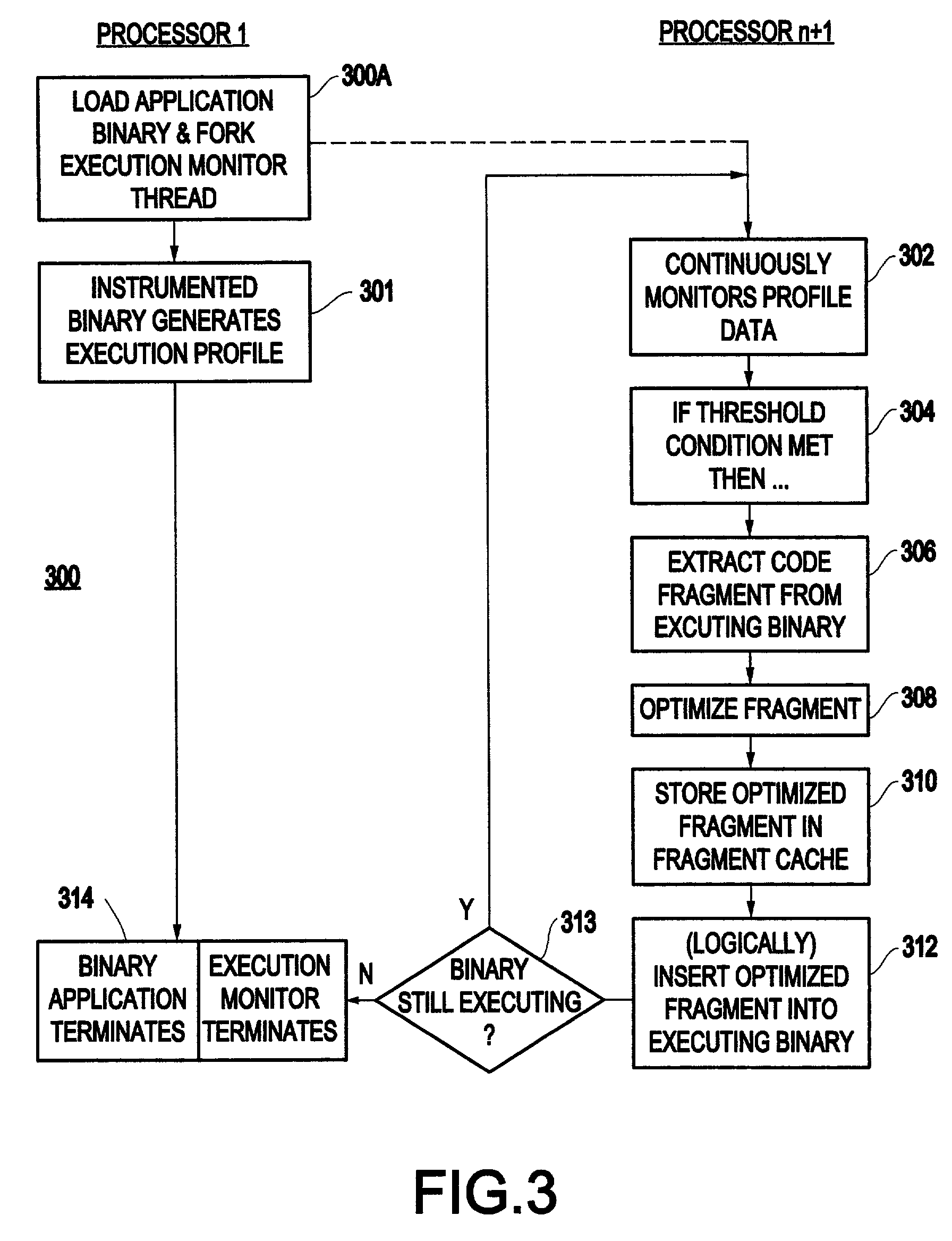Method and system for transparent dynamic optimization in a multiprocessing environment
a multiprocessor system and dynamic optimization technology, applied in the field of software systems, can solve the problems of insufficient, if not impossible, inability to generate test data, inability to generate efficient code, etc., and achieve the effect of improving the efficiency of program execution in multiprocessor systems
- Summary
- Abstract
- Description
- Claims
- Application Information
AI Technical Summary
Benefits of technology
Problems solved by technology
Method used
Image
Examples
embodiment
Preferred Embodiment
[0042]Generally, the present invention exploits multiprocessing capability in a new way to achieve significant performance improvement in the execution of programs on multiprocessor systems. Purely static compilers generally assume that all paths in a program are equally likely to be taken and therefore typically optimize all possible paths to the same extent. However, since some paths may, in practice, be taken more often, optimization may be more beneficial if key paths are selected for optimization, even at the expense of slowing less-frequently taken paths.
[0043]On the other hand, purely dynamic compilers (such as most just-in-time (JIT) compilers for Java® bytecode programs), while being possessed of detailed information regarding the current execution of a program, are severely hampered by the exigencies of needing to use this intelligence within a narrow temporal window.
[0044]As will become evident below, the present invention has two advantages over known...
second embodiment
[0104]Another embodiment of the invention will now be discussed with reference to FIG. 4 and is an improvement over the process of FIG. 3, and specifically can be employed in step 308 of FIG. 3.
[0105]That is, in step 308 of FIG. 3, the dynamic optimizer 207 examines a fragment and analyzes the same to determine what optimization can be performed to optimize the fragment. This decision to optimize is based only on what the dynamic optimizer can observe at that time.
[0106]In the method 400 of FIG. 4, additional steps are taken to perform a better optimization by dynamic optimizer 207. In this regard, additional information is provided to dynamic optimizer 207 in step 308 so that the optimizer can operate more rapidly and without the optimizer having to compute such information itself. Moreover, the optimizer can be provided possibly with information which it might otherwise find difficult to extract on its own.
[0107]Specifically, FIG. 4 shows a method 400 of dynamic optimization that ...
third embodiment
[0123]Turning to a flowchart of a process 600 in FIG. 6, another embodiment of the dynamic optimization system in accordance with the invention includes the capability for detection of, during execution of a binary application to be optimized, certain non-instrumented modules of the binary application which have previously been executed frequently.
[0124]If such modules are detected (step 610), the invention provides for the automatic insertion of instrumentation code for subsequent monitoring and optimization. It is noted that the contents of FIG. 6 can be seen as a special case of optimization, and logically the steps of FIG. 6 fit between box 306 and box 312 in FIG. 3.
[0125]To avoid modifying code which might be potentially “shared” among other applications, in step 620, the system makes a copy of the original module (unprofiled binary) and maintains a list of any modules so changed.
[0126]Then, step 630 invokes the method to instrument the binary. On a future invocation of the mod...
PUM
 Login to View More
Login to View More Abstract
Description
Claims
Application Information
 Login to View More
Login to View More - R&D
- Intellectual Property
- Life Sciences
- Materials
- Tech Scout
- Unparalleled Data Quality
- Higher Quality Content
- 60% Fewer Hallucinations
Browse by: Latest US Patents, China's latest patents, Technical Efficacy Thesaurus, Application Domain, Technology Topic, Popular Technical Reports.
© 2025 PatSnap. All rights reserved.Legal|Privacy policy|Modern Slavery Act Transparency Statement|Sitemap|About US| Contact US: help@patsnap.com



